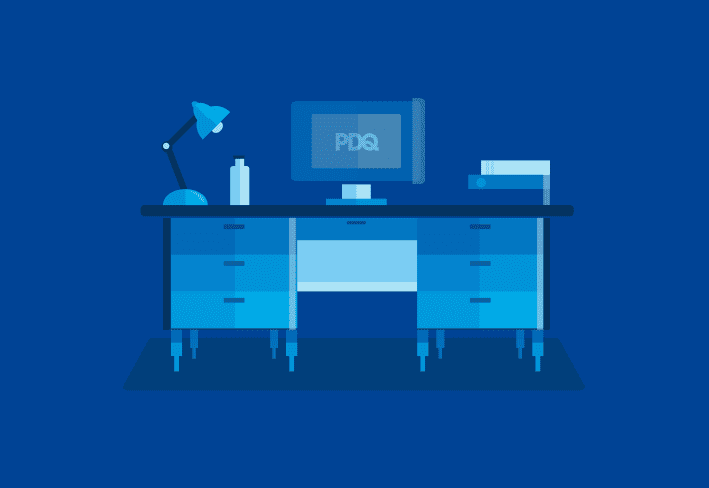Platform as a service, or PaaS, is a type of cloud computing service. When you partner with a PaaS provider, you gain access to a cloud service provider’s infrastructure and development tools. In turn, you can develop cloud-based applications.
If you regularly read our PDQ blog (and if you don’t, you totally should), you may have seen our blog defining infrastructure as a service, or IaaS. In short, PaaS is one step above IaaS but one step below software as a service, or SaaS.
PaaS gives you everything IaaS gives you (infrastructure such as servers and storage) as well as the tools to do something with that infrastructure (middleware, management tools, operating systems, etc.).
What is cloud computing?
Cloud computing is the process of accessing the cloud (and the servers, storage, applications, and networking components that make up the cloud) remotely via the internet.
Need a more in-depth refresher? Check out our guide to cloud computing.
How PaaS works
Just like with IaaS, when you sign up for PaaS services, you essentially lease physical hardware that you access via the cloud. But you also lease tools that enable you to build things on that infrastructure. You gain access to middleware, which bridges the gap between programs and systems and helps them communicate with each other. In turn, the applications you build in the cloud can run.
Your engineers may spend some time in your PaaS environment writing and testing code to prepare an application for deployment.
Common use cases for PaaS
IT teams often use PaaS services in a few key ways.
Application testing and deployment
Just like IaaS, PaaS offers a sandbox environment for the testing and development of applications. But PaaS environments offer more than just the infrastructure. They also offer tools, such as middleware and developed application components, to make testing and developing more efficient.
DevOps support
In a similar vein, PaaS offers the tools and capabilities that DevOps teams need to do their jobs more efficiently. PaaS tools enable DevOps teams to develop, test, and manage software — all without needing to configure or provision test environments. Plus, PaaS solutions help to minimize downtime as DevOps teams can test to ensure applications are fully ready to deploy to a prod environment.
Cloud migration and integration
The cloud provides scalability that traditional on-prem environments can’t. As a result, some teams choose to move specific projects to the cloud. PaaS setups include the tools and capabilities that make the migration easier. And through integration options, you can connect your on-prem applications to your cloud-hosted applications, making way for a seamless experience.
The difference between IaaS and PaaS
Infrastructure as a service is often compared to platform as a service, or PaaS. While IaaS is the base-level tier of cloud computing services, PaaS is a step above IaaS. PaaS allows you to develop applications without having to build or maintain servers. With IaaS setups, it’s on you to do the provisioning and configuring.
How to implement PaaS
You can implement most PaaS solutions by following these steps. And if you read our blog on IaaS solutions, you'll probably feel some déjà vu in just a few moments.
1. Round up your core team
Implementation isn’t very fun as a solo activity (and truthfully, not much more fun as a group activity). It’s always best to go about implementing PaaS with a core team that can help you plan and execute (a̶n̶d̶ v̶e̶n̶t̶ a̶l̶o̶n̶g̶ t̶h̶e̶ w̶a̶y̶).
2. Identify your use cases
Think about the ways your IT team might benefit from the PaaS solution. Talk to your DevOps team, your engineers, and anyone else in your organization who might use your PaaS solution. See what their needs are, and jot them down. You’ll need them for the next few steps.
3. Scope out the requirements
Introspection time! Take a good look at your current infrastructure and think about how a PaaS solution might integrate with it. What specifics will your organization need from your PaaS solution? Jot those down.
4. Select a PaaS provider
Similar to IaaS providers, there are quite a few PaaS providers to choose from. A few notable options include the following:
Amazon (AWS Elastic Beanstalk)
Google (Google App Engine)
Microsoft (Microsoft Azure App Service)
Heroku
IBM (IBM Cloud Foundry)
Oracle (Oracle Cloud Platform)
5. Migrate
And now, everyone’s favorite step: migrating! 😅
Like with IaaS, PaaS migrations require a lot of work that often takes years to complete. Working with your core team, you’ll need to figure out which applications you need to migrate to your PaaS instance, the types of data you want to migrate (and how to do so safely), and how best to migrate in phases.
Benefits of PaaS
There are a few notable benefits of PaaS solutions.
More efficient coding capabilities
PaaS solutions might make coding feel less daunting. With built-in, usable coding components, your team can drag and drop usable snippets and speed up the process, cutting down the time it takes for your code to enter your prod environment.
Fewer hardware management responsibilities
With traditional on-prem environments, your team is responsible for updating and managing your hardware. If a machine fails, it’s your problem. But with PaaS solutions, your PaaS provider is responsible for maintaining and upkeeping hardware.
Cost savings
With PaaS solutions, you can scale up or down, and you pay only for what you use. Your cloud environment is always ready whenever you need it — no additional on-prem hardware required.
Disadvantages of PaaS
There are also a few disadvantages of PaaS you should be aware of before signing on the dotted line.
Compatibility issues
It’s possible that you may have issues when you try to integrate your existing development platform with your PaaS solution. The fun thing about technology is it's often unpredictable whether your programs and platforms will play along nicely with one another or refuse to speak at all. Make sure you speak with any potential PaaS providers about your existing platforms and tools to make sure there won’t be any compatibility issues.
Security concerns
When you choose a PaaS provider, you’re placing a lot of trust in them because it’s up to them to secure the PaaS tools and platforms. But the onus is on you to make sure what you build in your PaaS instance is secure. You’ll need to take a few extra steps to make sure your provider takes security seriously — and that your team is equipped with the tools they need to develop secure applications.
Unexpected costs
The costs associated with PaaS providers are both a blessing and a curse. You pay only for what you use — but if the passionate engineers on your team get a little carried away with a project, costs can add up fast. It’s important to be aware of how PaaS providers charge you for services so you can be prepared for when the bill hits your desk.
And speaking of making life easier, PDQ Connect can help you keep your environment secure and up to date from the cloud. Deploy custom or prebuilt packages, streamline your tasks, and manage your devices — wherever they're located. Sign up for a free 14-day trial of PDQ Connect.



